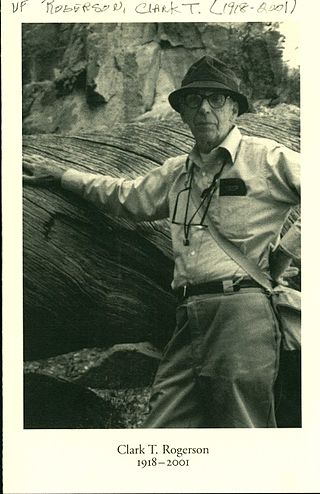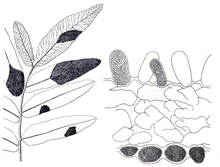
Petter Adolf Karsten was a Finnish mycologist, the foremost expert on the fungi of Finland in his day, and known in consequence as the "father of Finnish mycology".

Charles Horton Peck was an American mycologist of the 19th and early 20th centuries. He was the New York State Botanist from 1867 to 1915, a period in which he described over 2,700 species of North American fungi.

Alexander Hanchett Smith was an American mycologist known for his extensive contributions to the taxonomy and phylogeny of the higher fungi, especially the agarics.
Gilkeya is a genus of fungi in the family Pyronemataceae. It is monotypic, containing the single species Gilkeya compacta. It is named after the American mycologist Helen Margaret Gilkey (1886–1972).
Seaverinia is a genus of fungi in the family Sclerotiniaceae. This is a monotypic genus, containing the single species Seaverinia geranii.
Korfia is a genus of fungi in the family Hemiphacidiaceae. This is a monotypic genus, containing the single species Korfia tsugae.
Lohwagia is a genus of fungi in the family Phyllachoraceae. The genus was described by Austrian-Czech mycologist Franz Petrak in 1942. Lohwagia contains three species: the type L. intermedia, L. kessleriana and L. verruciformis.
Diehliomyces is a genus of fungi in the Ascomycota phylum. The relationship of this taxon to other taxa within the phylum is unknown, and it has not yet been placed with certainty into any class, order, or family. This is a monotypic genus, containing the single species Diehliomyces microsporus.
Zugazaea is a fungal genus in the order Helotiales. The relationship of this taxon to other taxa within the order is unknown, and it has not yet been placed with certainty into any family. This is a monotypic genus, containing the single species Zugazaea agyrioides, which was found growing on decomposing wood in the Canary Islands. The fungus produces small, dull orange fruitbodies that seem to be embedded in a resinous or mulicaginous material. The type species is named for its resemblance to some members of the genus Agyrium.
Haasiella is a fungal genus in the family Hygrophoraceae. It is a monotypic genus that contains only the species Haasiella splendidissima. Haasiella venustissima, formerly considered to be a distinct species based on its one and two-spored basidia, was found by a DNA study to be synonymous with H. splendidissima. H. splendidissima is only known from Europe and is saprotrophic on wood. Haasiella was described as a new genus in 1966 by Czech mycologists František Kotlaba and Zdeněk Pouzar. It is most closely related to the genus Hygrophorus.
Gilbertsonia is a fungal genus in the family Fomitopsidaceae. This is a monotypic genus, containing the single brown rot species Gilbertsonia angulipora, found in the United States. Gilbertsonia is characterized by a dimitic hyphal system with clamped generative and well-developed binding hyphae. The generic name honors mycologist Robert Lee Gilbertson.
Gamsiella is a fungal genus in the Mortierellaceae family of the Zygomycota. The genus is monotypic, containing the single species Gamsiella multidivaricata, found in the United States.

Sutorius is a genus of fungi in the family Boletaceae. Its type species is the widely distributed Sutorius eximius. The Asian Boletus obscureumbrinus, found in Japan and China, was described by Japanese mycologist Tsuguo Hongo in 1968, moved to genus Sutorius in 2016, but then reclassified into genus Neoboletus in 2019. The Australian Sutorius australiensis and the southern Chinese Sutorius subrufus also belong to the genus.

Edwin Butterworth Mains (1890–1968) was an American mycologist. He was known for his taxonomic research on the rust fungi (Pucciniomycetes), the genus Cordyceps, and the earth tongues (Geoglossaceae).
Imaia is a fungal genus in the family Morchellaceae found in Japan, and in the Appalachian Mountains of the US. A monotypic genus, Imaia was circumscribed in 2008 by James Martin Trappe and Gábor M. Kovácsto to contain the truffle-like species formerly known as Terfezia gigantea when molecular analysis demonstrated that its DNA sequences were markedly different from those of Terfezia. The fruit bodies of Imaia gigantea are spherical to roughly elliptical to irregular in shape, brown, and usually develop cracks in age. The interior gleba comprises brown pockets of asci separated by white veins. The spores are spherical or nearly so, up to 70 µm long, and enclosed by a thick epispore.

Clark Thomas Rogerson,, was an American mycologist. He was known for his work in the Hypocreales (Ascomycota), particularly Hypomyces, a genus of fungi that parasitize other fungi. After receiving his doctorate from Cornell University in 1950, he went on to join the faculty of Kansas State University. In 1958, he became a curator at The New York Botanical Garden, and served as editor for various academic journals published by the Garden. Rogerson was involved with the Mycological Society of America, serving in various positions, including president in 1969. He was managing editor (1958–89) and editor-in-chief (1960–65) of the scientific journal Mycologia.
Nowakowskiella is the sole genus of fungi in the family Nowakowskiellaceae. The genus was circumscribed by German mycologist Joseph Schröter in 1897, while the family was originally circumscribed by Frederick Kroeber Sparrow in 1942, and then published validly in 2009.
Robert Bauer was a German mycologist, specialising in rust (Uredinales) and smut (Ustilaginomycetes) fungi.
Kabatiella is a genus of fungi belonging to the family Saccotheciaceae.
Carlo Antonio Maria Venturi was an Italian mycologist. In 1842 he published Mycological Studies, in which he described sixty-two species of fungi. In 1845 he published miceti dell'agro bresciano descritti ed illustrati con figure tratte dal vero.






